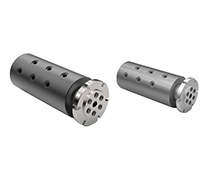Slip Rings
Slip Ring Union
Rotary Unions
Technical Support
Wind Turbine Brushless Slip Ring
Due to the increase in energy prices, wind energy as an environmentally safe and relatively inexpensive alternative energy has attracted more and more attention, so each fan manufacturers continue research and development of reliable and efficient wind turbines.
Generally, known wind turbine includes a rotor having a plurality of blades, the rotor is mounted to a housing or nacelle at the top of the cylindrical tower. Utility-scale wind turbines can have large rotors (diameter 30 m or more), the rotor blades on the wind energy into a rotational torque or force that drives can be directly or delivered to one or more power through a gearbox machine. Gearbox increase promotes generator turbine rotor efficiently convert mechanical energy to electrical energy, then transferred to the utility grid.
Direct drive or geared wind turbines for the transfer slip ring currents may fail prematurely, known slip ring brushes group generally used to pass current from the rotating axial fixation member, however, this brush set over time there will be wear and generally require periodic replacement, replacement brushes group increased operating costs of wind turbines, in some cases, replace the brush group requires wind turbines in the non-operating condition, face electricity brush wear problem, it began to develop a brushless slip ring to meet the current shortage. Brushless slip ring has two types, one is by mercury transmission medium current, but mercury is not conducive to the manufacture of the slip ring, distribution, maintenance, since mercury is toxic, and requires special handling of hazardous materials; another is the use of wireless power technology, such technology is difficult, and difficult to transport large current , loss is relatively large, currently it have this type of product into the market.
In short, the current wind power brushless slip ring technology is not mature, but also takes a long time trials and research and development, hoping to be widely used in the field of wind power in the near future.



